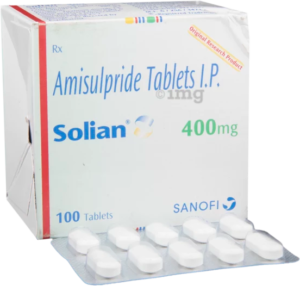Amisulpride | Solian
Solian is indicated for the treatment of acute and chronic schizophrenic disorders, in which positive symptoms (such as delusions, hallucinations, thought disorders) and/or negative symptoms (such as blunted affect, emotional and social withdrawal) are prominent, including patients characterized by predominant negative symptoms.
For acute psychotic episodes, oral doses between 400 mg/d and 800 mg/d are recommended. In individual cases, the daily dose may be increased up to 1200 mg/d. Doses above 1200 mg/d have not been extensively evaluated for safety and therefore should not be used. No specific titration is required when initiating the treatment with Solian. Doses should be adjusted according to individual response.

For patients with mixed positive and negative symptoms, doses should be adjusted to obtain optimal control of positive symptoms. Maintenance treatment should be established individually with the minimally effective dose. For patients characterised by predominant negative symptoms, oral doses between 50 mg/d and 300 mg/d are recommended. Doses should be adjusted individually.
Solian can be administered once daily at oral doses up to 300 mg, higher doses should be administered bid. The minimum effective dose should be used.
Elderly: The safety of amisulpride has been examined in a limited number of elderly patients. Amisulpride should be used with particular caution because of a possible risk of hypotension and sedation. Reduction in dosage may also be required because of renal insufficiency.
Children: The efficacy and safety of amisulpride from puberty to the age of 18 years have not been established. There are limited data available on the use of amisulpride in adolescents in schizophrenia. Therefore, the use of amisulpride from puberty to the age of 18 years is not recommended; in children up to puberty amisulpride is contraindicated, as its safety has not yet been established (see Section 4.3).
—–INDICATIONS AND USAGE—–
- See description above.
—–DOSAGE AND ADMINISTRATION—–
- Dosage should be individualized for maximum beneficial effect. While the usual daily dosages given below will meet the needs of most patients, there will be some who require doses greater than 4 mg/day. In such cases, dosage should be increased cautiously to avoid adverse effects.
—–DOSAGE FORM AND STRENGTHS—–
- Each XANAX Tablet, for oral administration, contains 0.25, 0.5, 1 or 2 mg of alprazolam.
—–CONTRAINDICATIONS—–
- XANAX Tablets are contraindicated in patients with known sensitivity to this drug or other benzodiazepines. XANAX may be used in patients with open angle glaucoma who are receiving appropriate therapy, but is contraindicated in patients with acute narrow angle glaucoma. XANAX is contraindicated with ketoconazole and itraconazole, since these medications significantly impair the oxidative metabolism mediated by cytochrome P450 3A (CYP3A)
—–WARNINGS—–
- Dependence and Withdrawal Reactions, Including Seizures
- Status Epilepticus and its Treatment
- Interdose Symptoms
- Risk of Dose Reduction
- CNS Depression and Impaired Performance
- Risk of Fetal Harm
- Alprazolam Interaction with Drugs that Inhibit Metabolism via Cytochrome P4503A
- Potent CYP3A Inhibitors
—–PRECAUTIONS—–
- Suicide: As with other psychotropic medications, the usual precautions with respect to administration of the drug and size of the prescription are indicated for severely depressed patients or those in whom there is reason to expect concealed suicidal ideation or plans. Panic disorder has been associated with primary and secondary major depressive disorders and increased reports of suicide among untreated patients.
- Mania: Episodes of hypomania and mania have been reported in association with the use of XANAX in patients with depression.
- Uricosuric Effect: Alprazolam has a weak uricosuric effect. Although other medications with weak uricosuric effect have been reported to cause acute renal failure, there have been no reported instances of acute renal failure attributable to therapy with XANAX.
- Use in Patients with Concomitant Illness: It is recommended that the dosage be limited to the smallest effective dose to preclude the development of ataxia or oversedation which may be a particular problem in elderly or debilitated patients.
—–ADVERSE REACTIONS—–
- Side effects to XANAX Tablets, if they occur, are generally observed at the beginning of therapy and usually disappear upon continued medication. In the usual patient, the most frequent side effects are likely to be an extension of the pharmacological activity of alprazolam, eg, drowsiness or light-headedness.
—–DRUG INTERACTIONS—–
- Use with Other CNS Depressants: If XANAX Tablets are to be combined with other psychotropic agents or anticonvulsant drugs, careful consideration should be given to the pharmacology of the agents to be employed, particularly with compounds which might potentiate the action of benzodiazepines.
- Use with Imipramine and Desipramine: The steady state plasma concentrations of imipramine and desipramine have been reported to be increased an average of 31% and 20%, respectively, by the concomitant administration of XANAX Tablets in doses up to 4 mg/day. The clinical significance of these changes is unknown.
- Drugs that inhibit alprazolam metabolism via cytochrome P450 3A: The initial step in alprazolam metabolism is hydroxylation catalyzed by cytochrome P450 3A (CYP3A). Drugs which inhibit this metabolic pathway may have a profound effect on the clearance of alprazolam.
- Fluoxetine: Coadministration of fluoxetine with alprazolam increased the maximum plasma concentration of alprazolam by 46%, decreased clearance by 21%, increased half-life by 17%, and decreased measured psychomotor performance.
- Propoxyphene: Coadministration of propoxyphene decreased the maximum plasma concentration of alprazolam by 6%, decreased clearance by 38%, and increased half-life by 58%.
- Oral Contraceptives: Coadministration of oral contraceptives increased the maximum plasma concentration of alprazolam by 18%, decreased clearance by 22%, and increased half-life by 29%

